Making wine is simple! Basically all you need to do is extract the juice from fruit or vegetables, add sugar and yeast and then sit back and wait for the yeast to turn the sugar into alcohol.
When you have read this page you may like to learn more about wine making. I recommend that you take a look at this book-
The quantities shown below are those required to make one gallon of wine. If you are making any other volume then scale the quantities accordingly.
Step 1:
Gather the Ingredients
The first ingredient is of course pea pods. Remove all the peas prior to use.
I got these pods from my garden. Peas are easy to grow - why not have a go? |
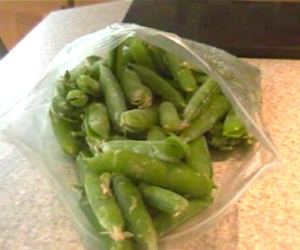 |
The next ingredient is Citric Acid . .
You can get Citric Acid in powder form or you can get it by squeezing the juice from lemons. in powder form or you can get it by squeezing the juice from lemons. |
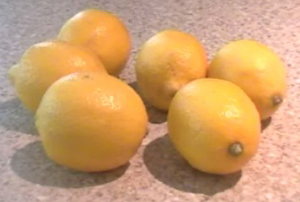 |
Sultanas- these were bought from a local superstore. The sultanas are full of natural sugar and give a light fruity flavour to the wine. |
|
Sugar -Some wine makers recommend that you use Brewing & Wine Making Sugar but I use white granulated cane sugar bought from a supermarket.
Do not use Brown or Demerara Sugar as this will give the wine a golden tinge and may give the wine a slight flavour. |
|
Wine Tannin can be bought in tubs as shown or you can add half a pint of strong tea to each gallon of wine.
can be bought in tubs as shown or you can add half a pint of strong tea to each gallon of wine.
Tannin gives a dry taste in the mouth after the wine has been swallowed. Tannin comes naturally in fruit skins - especially red fruit, but is not present in pea pods so must be added.
gives a dry taste in the mouth after the wine has been swallowed. Tannin comes naturally in fruit skins - especially red fruit, but is not present in pea pods so must be added. |
|
Boiling the pea pods releases pectins which leave the wine with a hazy look.
Pectolase (or Pectin Enzyme) destroys the pectins giving you a crystal clear wine.
destroys the pectins giving you a crystal clear wine.
Warning: Only add the Pectolase when the juice is cool. |
|
Yeast is a living organism that feeds off the sugar, turning it into alcohol. For Pea Pod wine I used Super Wine Yeast Compound .
.
Yeast Nutrient is a food for the yeast - it helps the yeast grow and multiply.
is a food for the yeast - it helps the yeast grow and multiply.
|
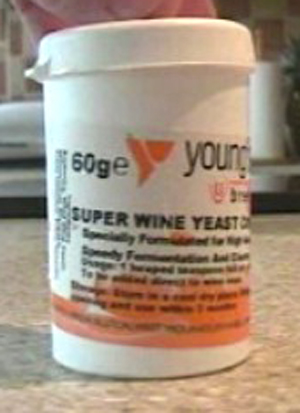 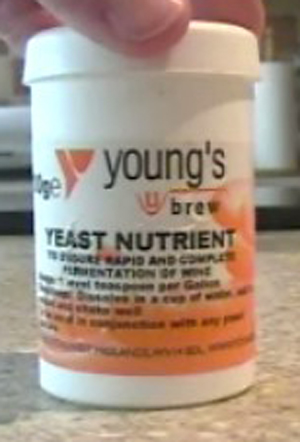 |
Campden Tablets are used to sterilise your equipment.
are used to sterilise your equipment.
I cannot over emphasise that you must sterilise every item that you use. Bacteria is the enemy of successful wine making - it can turn alcohol into vinegar so be thorough with your cleaning. |
|
Step 2:
Place the water(7 pints for each gallon of wine) in a Boiling Pot and bring it to the boil.
and bring it to the boil. |
|
Step 3:
Wash the Pea Pods and add to the boiling water.
Simmer until the pods are tender |
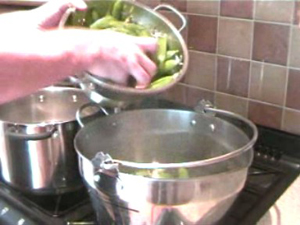 |
Step 4:
Sterilise your Brewing Bucket and other equipment. and other equipment.
Add one Campden Tablet to the bucket and disolve in one pint of boiling water. Use this solution to sterilise other equipment. to the bucket and disolve in one pint of boiling water. Use this solution to sterilise other equipment. |
|
Step 5:
Chop the Lemons and extract the juice. |
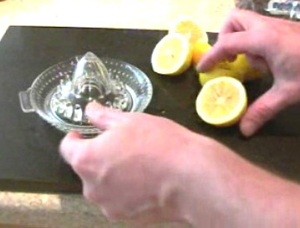 |
Step 6:
Chop the sultanas and add to the brewing bucket.
Chopping the sultanas lets the yeast get at the sugar inside them. |
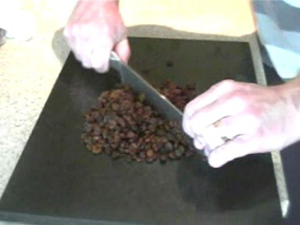 |
Step 7:
Add the sugar. |
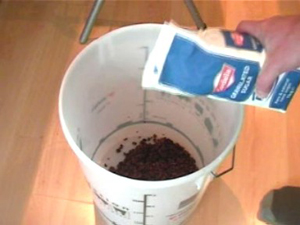 |
Step 8:
Strain the Pea Pods through a sieve into the brewing bucket.
into the brewing bucket.
Stir the sugar to disolve it and allow the juice to cool. |
|
Step 9:
Make a starter jar for the yeast . The purpose of this step is to get the yeast to start fermenting in a small jar with a low sugar content before adding it to your main juice mixture. . The purpose of this step is to get the yeast to start fermenting in a small jar with a low sugar content before adding it to your main juice mixture.
Sterilise a glass tumbler, add a teaspoon of sugar, and pour on boiling water. Stir the sugar until it disolves and then let it to cool to room temperature.
Next add a pinch of Yeast Nutrient and a teaspoon of the yeast. Cover the top of the tumber with cling film. After a few minutes the yeast will start fermenting - bubbles will rise from the bottom of the tumbler and a froth will appear at the top. Leave for about 4 hours at room temperature. and a teaspoon of the yeast. Cover the top of the tumber with cling film. After a few minutes the yeast will start fermenting - bubbles will rise from the bottom of the tumbler and a froth will appear at the top. Leave for about 4 hours at room temperature.
|
|
Step 10:
Add the yeast and Yeast Nutrient and Yeast Nutrient to the juice. to the juice.
Important: Dont add the yeast until the water is at room temperature or you will kill it. Yeast is a living organism and cannot survive at temperatures above 30 degrees C. |
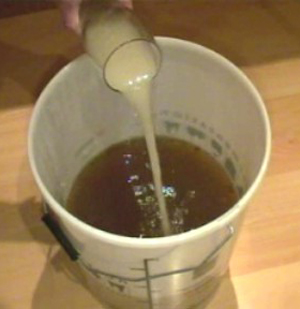 |
Step 11:
Add the Wine Tannin (or cold tea - see ingredients for details) (or cold tea - see ingredients for details) |
|
Step 11:
Put the lid on the Brewing Bucket and leave to ferment for 8 to 9 days. and leave to ferment for 8 to 9 days.
The sultanas willl float on the surface so stir daily to get them into contact with the yeast. |
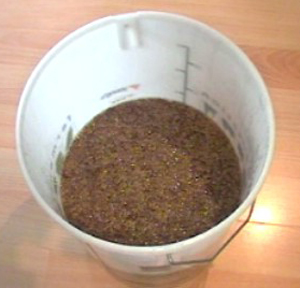 |
Step 12:
Sterilise a second Brewing Bucket , Muslin Cloth , Muslin Cloth and sieve
and sieve . .
Place the cloth over the strainer and pour the wine so that the sultanas are caught in the sieve. |
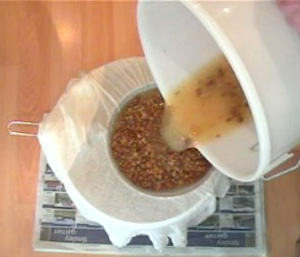 |
Step 13:
Wring the juice out of the sultanas inside the Muslin Cloth . .
Cover the Brewing Bucket as before and leave for a further 3 to 4 days. as before and leave for a further 3 to 4 days. |
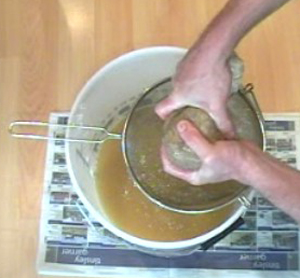 |
Step 14:
Sterilise a demijohn and siphon tube and siphon tube . . |
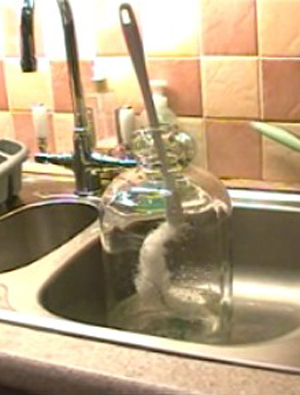 |
Step 15:
Siphon the wine from the Brewing Bucket into the Demijohn into the Demijohn leaving behind as much sediment as possible. leaving behind as much sediment as possible. |
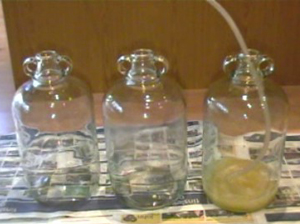 |
Step 16:
Top up the Demijohn to the neck with boiled water that has bee allowed to cool. to the neck with boiled water that has bee allowed to cool.
Fit a Rubber Bung and an Airlock
and an Airlock . Add sterilised water to the airlock to stop air getting into the Demijohn . Add sterilised water to the airlock to stop air getting into the Demijohn . .
Leave until all fermentation has stopped (bubbles cease). |
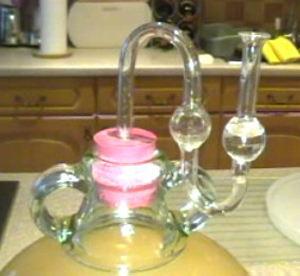 |
Step 17:
Syphon off the wine into a sterilised Demijohn. Leave behind as much yeast deposit as possible. A syphon tube fitted with a trap is ideal for this.
is ideal for this.
Top up to the rim with boiled water that has been allowed to cool.
Fit a cork ( not an airlock) and leave in a cool dark place until the wine is completely clear - this could take from weeks to months. |
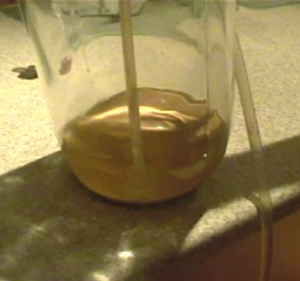 |
Step 18:
Wash and sterilise your bottles using a Bottle Brush . I have re-used old bottles but you can buy new Wine Bottles
. I have re-used old bottles but you can buy new Wine Bottles if you prefer.
if you prefer. |
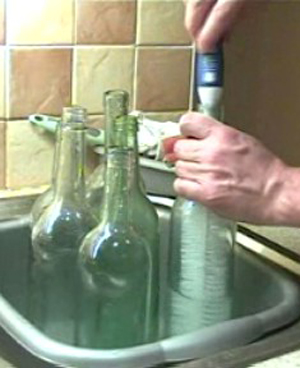 |
| This is my wine six months after it was brewed. You can see it is now completely clear. |
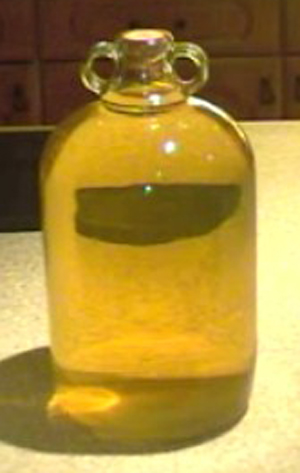 |
Step 19:
Siphon the wine into your bottles. |
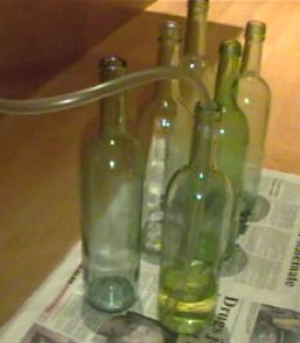 |
Step 20:
Fit Corks to the bottles using a Corker
to the bottles using a Corker .
. |
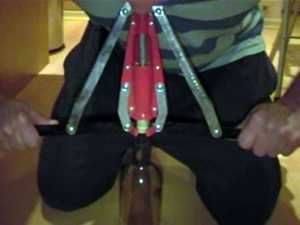 |
Step 21:
Drink!
6 bottles of great tasting, low cost wine to be enjoyed at your leisure!
PS. To give your bottles a more professional look fit Wine Bottle Labels
|
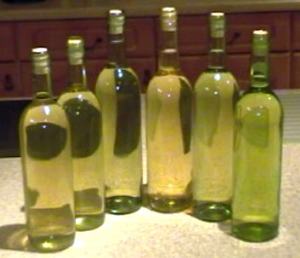 |

